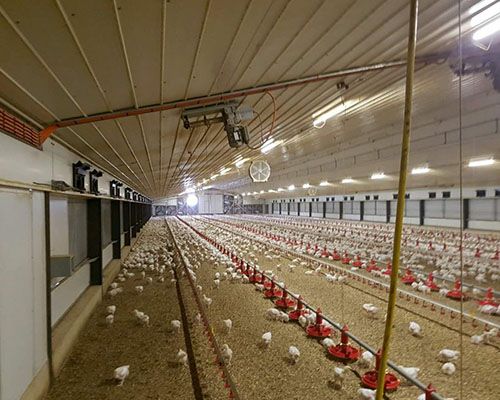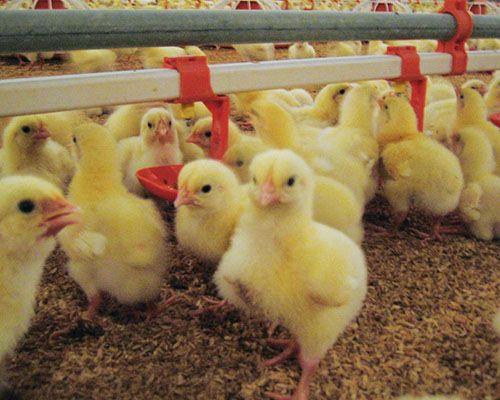Company news
How much does the chicken house contain chicken disinfection?
Added:2021-05-27
1, what is the chicken disinfection
Disinfection with chicken is to raise the chicken in the chicken house, use a reasonable proportion of disinfectant drugs that are less irritating to the chicken, and evenly spray it in the inner space with a certain pressure to disinfect and reduce dust and prevent it. A method of disinfection of the disease.
2, with the role of chicken disinfection
(1) Disinfection with chicken can kill or reduce pathogenic microorganisms in the house;
(2) The solid matter suspended in the air can be agglomerated and settled to achieve the purpose of purifying the air;
(3) It acts to humidify during drying and to cool down at high temperatures.
3, the specific operation with chicken disinfection
(1) Preparation before disinfection
Disinfection with chicken should reduce the dirt in the environment after cleaning and cleaning, and it can exert better disinfection effect.
(2) Preparation of disinfectant
The dosage of disinfectant is calculated according to the recommended concentration and water consumption of the instructions. The water consumption is estimated according to the space of the house. Generally, 50-100 mL of water is required per cubic meter of house. In different seasons, the disinfection water should be flexible and warm in the weather. The amount should be too large, and the calculation should be based on the upper limit of the standard; if the weather is cold and the temperature is poor, the dosage will be less, and the lower limit of the standard will be calculated.
(3) Disinfection sequence
Generally, from top to bottom, that is, the order of the first beam, the wall and then the ground; from the back to the front, that is, from the inside to the outside of the house, if longitudinal mechanical ventilation is used, the order is reversed and should be The tuyere is sterilized in the direction of air flow to the exhaust vent. The disinfection of the vents and the venting corners must be strictly and thoroughly, which is a key part of the blocking route.
(4) Disinfection time
Disinfection is carried out at around noon every day from 11:00 to 14:00, when the temperature is higher, it is more suitable for disinfection. According to the room temperature, the disinfection time can be long or short. When the temperature is high, the disinfection speed can be slowed down and the disinfection time can be extended to prevent heatstroke. When the temperature is low, the disinfection speed can be shortened and the disinfection time can be shortened to reduce the chickens. Cold stress.
(5) Disinfection method
The sterilizing gun should be sprayed evenly at a distance of 1.5-2 meters from the chicken. The disinfectant floats evenly on the cage, the body surface of the chicken and the ground, making the feathers of the chicken slightly wet. At the same time, spray and flush the beam and vents, and do not spray directly on the chicken body. Ventilation should be added after disinfection to reduce humidity, especially in hot summer months.
(6) Disinfection frequency
The chick house is disinfected once a day; the egg house is disinfected once a day or every other day depending on the degree of environmental pollution in the house.
4, matters needing attention
(1) Selection of disinfectant
You should understand the characteristics of various types of disinfectants and choose the appropriate disinfectant. It is necessary to choose a disinfectant that is less irritating to humans and chickens, has good sterilization or anti-virus effects, is easily soluble in water, and has no corrosion or corrosion to articles and equipment. At least 2-3 kinds of disinfectants are generally used. Currently, commonly used disinfectants include quaternary ammonium salts, iodine preparations and complex aldehydes. Each disinfectant has its own role, quaternary ammonium salts are cationic surfactants, mainly acting on bacteria; iodine preparations use their oxidizing ability to kill viruses; complex aldehydes can coagulate bacterial proteins, Bacteria and viruses have a good effect.
In the daily disinfection, several disinfectants should be used interchangeably. Some bacteria will be resistant to drugs for a long time. Alternate use can complement the advantages of disinfectants. Such as: long-acting bacteriostatic and rapid sterilization alternate, sensitive to bacteria and sensitive to viruses.
(2) Preparation of disinfectant
Be sure to completely dissolve the drug in water and mix it; powders and emulsions can dissolve the drug first and then expand it with water. The concentration of the ratio must be scientific and reasonable. Do not simply think that the higher the concentration, the better the effect. Each disinfectant has a better concentration range for its efficacy. Beyond this range, one is waste, but it will not achieve the effect; the second is easy to cause damage to the flock and the human body; the third is that some disinfectants can corrode the feeding equipment. It is recommended to use the concentration recommended by the manufacturer. Conditional farms can also determine the appropriate concentration by their own detection results.
The disinfectant should be completely reconstituted at one time before disinfection. When the liquid is not enough, suspend the disinfection. Dispensing the disinfectant is continued. It is strictly forbidden to disinfect while adding water. This will result in uneven concentration of the disinfectant and will not be disinfected. The disinfectant should be used now, and it should not be prepared in advance, and it should not be left unused to prevent the disinfectant from failing during the placement process.
(3) Temperature control of disinfection water
Within a certain range, the bactericidal power of the disinfectant is proportional to the temperature. When the temperature is increased, the bactericidal effect is increased. For every 10 °C increase in the temperature of the disinfectant, the sterilizing capacity is approximately doubled, but it cannot exceed 45 °C. Therefore, the summer disinfection effect is stronger than the winter. Use warm water with disinfectant, especially in winter with low temperature.
It is forbidden to disinfect or rinse the drinking fountain tube within 24 hours before and after immunization with live vaccine, otherwise it will affect the immune effect.


In short, in order to ensure the health of the flock, with chicken disinfection as an important part of epidemic prevention, a system should be formed, and it should be adhered to for a long time, sometimes not at all, when it is tight.

